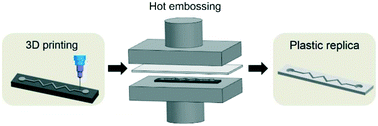3D printed metal molds for hot embossing plastic microfluidic devices†
Abstract
Plastics are one of the most commonly used materials for fabricating microfluidic devices. While various methods exist for fabricating plastic microdevices, hot embossing offers several unique advantages including high throughput, excellent compatibility with most thermoplastics and low start-up costs. However, hot embossing requires metal or silicon molds that are fabricated using CNC milling or microfabrication techniques which are time consuming, expensive and required skilled technicians. Here, we demonstrate for the first time the fabrication of plastic microchannels using 3D printed metal molds. Through optimization of the powder composition and processing parameters, we were able to generate stainless steel molds with superior material properties (density and surface finish) than previously reported 3D printed metal parts. Molds were used to fabricate poly(methyl methacrylate) (PMMA) replicas which exhibited good feature integrity and replication quality. Microchannels fabricated using these replicas exhibited leak-free operation and comparable flow performance as those fabricated from CNC milled molds. The speed and simplicity of this approach can greatly facilitate the development (i.e. prototyping) and manufacture of plastic microfluidic devices for research and commercial applications.


 Please wait while we load your content...
Please wait while we load your content...